In Brief
Finance & Development, June 2014, Vol. 51, No. 2
Tackling air pollution

In 2012, about 7 million people died—one in eight worldwide deaths—because of air pollution exposure, according to new estimates from the World Health Organization (WHO). This finding is more than double previous estimates and establishes air pollution as the single largest environmental health risk. Reducing air pollution could save millions of lives.
The new data reveal a stronger link between both indoor and outdoor air pollution exposure and cardiovascular disease, such as strokes and ischemic heart disease, as well as between air pollution and cancer. Air pollution has already been shown to play a role in the development of respiratory disease, including acute respiratory infections and chronic obstructive pulmonary disease.
Regionally, low- and middle-income countries in the WHO’s Southeast Asia and Western Pacific Regions bore the largest burden in 2012—3.3 million deaths were linked to indoor air pollution and 2.6 million deaths to outdoor air pollution.
South Asia’s infrastructure gap

It will take investment of as much as $2.5 trillion in transportation, electricity, water supply and sanitation, solid waste management, telecommunications, and irrigation for south Asia to bridge its infrastructure gap, according to a new World Bank report, Reducing Poverty by Closing South Asia's Infrastructure Gap.
South Asia’s economy grew on the order of 6.7 percent annually from 2000 to 2012. However, according to the report, the region’s growing demand for infrastructure has widened an existing infrastructure gap, defined as the difference between south Asia’s development goals and its ability to achieve them.
The report also emphasizes how women, the poor, and marginalized social groups are particularly affected.
The gap has taken a toll on the region’s growth and on households. Only two in five people in south Asia have access to improved sanitation. Seventy-one percent of people in the region have access to electricity versus 92 percent in east Asia. The effects of these deficiencies are intertwined, and factors such as the inadequate power supply, poor health, and limited transportation have kept south Asia’s manufacturing sector from growing as fast as once anticipated. Employment has suffered as a result, the report finds.
Growing greener cities
A new Food and Agriculture Organization (FAO) report shows that urban and periurban agriculture—cultivation, processing, and distribution of food around cities—is widespread in Latin America and the Caribbean, but it will take greater government support for it to reach its full potential.
“Growing Greener Cities in Latin America and the Caribbean” examines the progress toward building “greener cities” in which urban and periurban agriculture is recognized by public policy and included in urban development strategies. The report is based on the results of a survey in 23 countries and data on 110 cities and municipalities.
The new report includes profiles of agriculture practiced in and around cities such as, Belo Horizonte (Brazil), El Alto (Bolivia), Havana, Lima, Managua, Mexico City, Quito, Tegucigalpa, and Rosario (Argentina).
The main benefit of urban and periurban agriculture is improved access to food by low-income families. However, in 16 of the 23 countries surveyed, people engaged in this type of agriculture earned some income from the activity. Such agricultural programs tend to use technologies and practices that produce more and better-quality food with less reliance on agrochemicals.
The FAO says that growing greener cities with agriculture needs the support of government. However, only 12 of the 23 countries surveyed have national policies that explicitly promote urban and periurban agriculture.
Promoting gender equality

The United Nations Development Programme (UNDP) has launched a new regional project, “Mosharaka,” which means “participation” in Arabic. The project galvanizes efforts of government institutions, civil society, human rights councils, the private sector, the League of Arab States, and several UN agencies to foster participation of Arab women in public life, including in the political, economic, and social spheres.
“The participation of women is key to development—there can be no peace, no democracy, no prosperity, and no progress without the full and equal participation of women,” stressed Sima Bahous, UN assistant secretary-general and director of the UNDP’s Regional Bureau for Arab States, in a press release.
With the overall goal of encouraging faster progress in reducing gender inequality and promoting women’s empowerment, the project is pursuing four key goals:
• accelerating measures that promote gender equality and women’s political, economic, and social participation;
• reinforcing human security and equal access to justice through establishing frameworks for women, peace, and security;
• strengthening women’s participation in national institutions, professional associations, the media, civil society, and the private sector; and
• ensuring that women benefit from a rapid return to sustainable development after conflicts
Africa continues going mobile

From farming to banking, mobile technology is changing lives in Africa—fast, according to a Gallup article. Nearly two-thirds (65 percent) of households in 23 countries in sub-Saharan Africa had at least one mobile phone in 2013, with median growth of 27 percent since 2008 and median annual growth of 5 percent. But in countries such as Zimbabwe, growth has far outpaced the average, rising from 26 percent of households in 2008 to 80 percent in 2013, and 9 percent annually.
Sub-Saharan Africa is the second-largest mobile technology market after Asia and the fastest growing one: the Groupe Speciale Mobile Association (GSMA) forecasts that the region’s mobile users will reach 346 million by 2017. This growth has leapfrogged traditional landline phone connections. The median percentage of households with landlines in these 23 countries in 2013 was 2 percent—unchanged from 2008.
The growth in mobile phone ownership in sub-Saharan Africa has not been distributed equally across the subcontinent or even within countries. Mobile phones remain most common in urban households—in 2013, 80 percent had at least one—compared with 63 percent of rural households with at least one mobile phone. Six years ago 63 percent of urban households had at least one mobile, compared with 43 percent in rural areas.
Mobile phone penetration in 2013 was lower in rural areas and lowest among the poorest households, which leaves room for growth in the sub-Saharan African market. However, it may be difficult to sustain the current pace without more substantial infrastructure investment.
Asia's small firms need financing to grow
Small and medium-sized enterprises (SMEs) are the backbone of Asia’s economies, but they need better access to finance to grow and generate badly needed new jobs for the region, says a new Asian Development Bank (ADB) report, the Asia SME Finance Monitor.
“Most of Asia’s smaller firms are faced with difficulties in obtaining finance,” said Noritaka Akamatsu, deputy head of the ADB’s Office of Regional Economic Integration, in a press release. “SMEs need to be able to tap a wider range of nonbank financing options in addition to bank loans, including capital markets, if they are to realize their potential.”
SMEs make up 98 percent of businesses and employ 66 percent of the labor force in Asia, but they represent only 38 percent of the region’s GDP, which means that governments can boost economic growth by developing SMEs.
However, small firms lose out to larger companies where bank loans are concerned: banks cut their lending to SMEs dramatically in the wake of the 2008–09 global financial crisis in order to avoid risk and in their quest for financial stability.
Greater incorporation of nonbank financing options into national policies and support for other options, such as asset-based finance and capital market instruments, are needed. The report, which includes data on SMEs in 14 countries in the region, found that as the world economy becomes increasingly interlinked, SMEs that are part of intricate global supply chains will need access to further trade finance, supply chain finance, and innovative funding models that enable them to expand their business globally.
Events in 2014
June 4–5, Brussels, Belgium
Group of Seven Summit
June 26–27, Paris, France
Fourteenth International Monetary Fund Public Debt Management Forum
July 15, Fortaleza, Brazil
BRICS Summit
September 6–8, Kuala Lumpur, Malaysia
Global Economic Symposium
October 10–12, Washington D.C.
Annual Meetings of the IMF and the World Bank
November 13–14, Washington, D.C.
Fifteenth Jacques Polak Annual Research Conference: "Cross-Border Spillovers"





